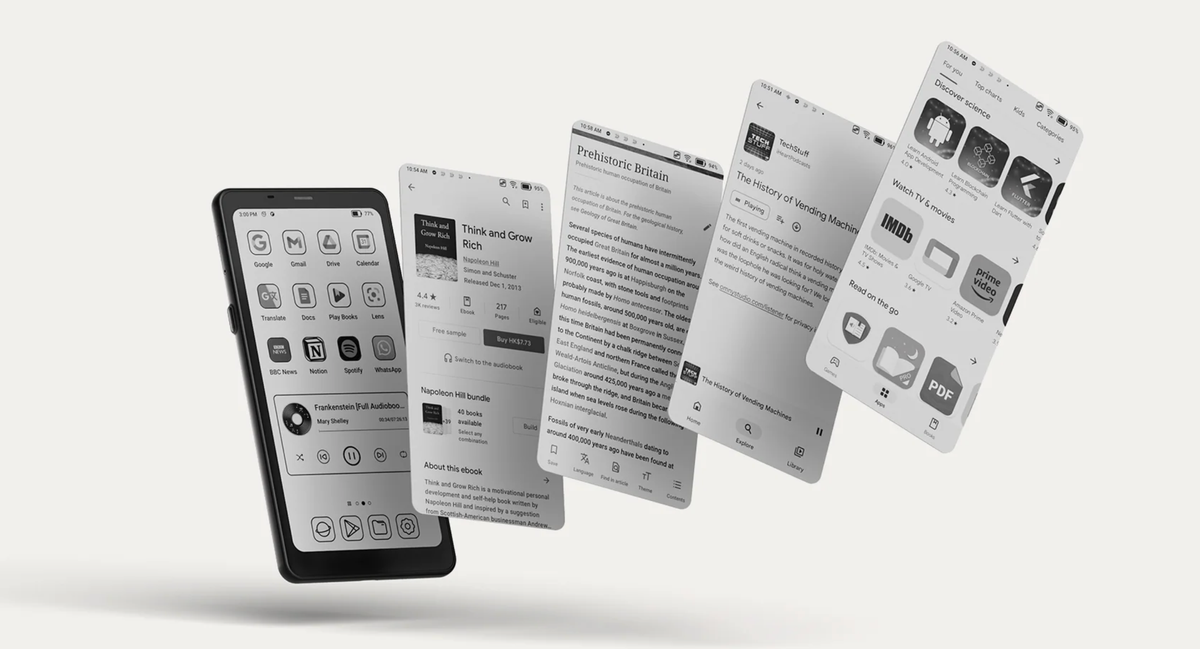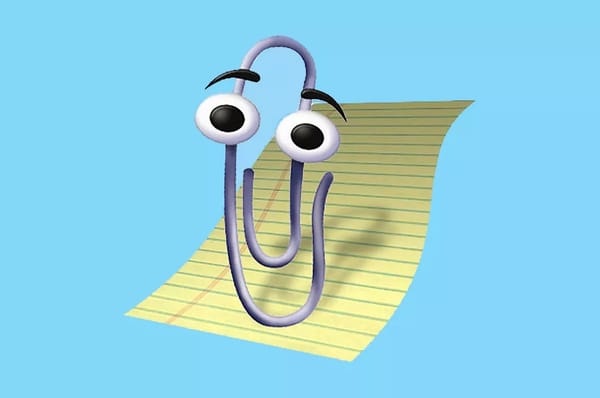It’s iPhone season! So I bought a 'phone' with an e-ink screen

If you’re a regular here, you’ll know that I’m an Apple fan. I explained recently how I’ve watched every Apple presentation for eighteen years straight. This year, of course, was no exception.
Apple releases a new iPhone every September, and this year was also no exception. There is one exception, though. This year I haven’t ordered the latest iPhone. Instead, I decided to buy an e-reader in the shape of a phone. It’s called the Boox Palma, and it’s really bad. It has a janky, slow-to-load screen. It can’t show colours. It has no front facing camera. It doesn’t even have a cellular connection.
Yet, all of these things have made the device a joy to use. I love it. It’s rubbish, yet it’s perhaps one of my favourite new devices. I like it more than the Ray Ban Meta smart glasses I tried (and returned) a few weeks back. I think I feel more relaxed and less anxious since I’ve had it. It makes no sense, except it makes so much sense when you pause and think about it.
I love it because it’s an e-reader that fits in my pocket. And because it runs Android, I can choose my book app of choice (I chose the Kindle app), and I can read news apps downloaded from Google Play and newsletters via an RSS app.
Although Android means I can technically do so much more, the e-ink display guarantees that I won’t. And that means I’m reading more, and scrolling less.
I think this says something about the state of consumer technology in 2024. Let’s pull on that thread a little today.
It’s amazing that I came across this product at all
Today, the biggest technology companies are spending billions on marketing their latest products – from Google being always in my face, everywhere I go about Pixel 9 and Gemini, to Apple’s now incredibly high polish regular events with an increasingly huge media reach, to Samsung literally renaming Old Street Station in London (I hated this one): marketing the latest gadgets is big business.
This market that was once for technology enthusiasts is now very heavily commoditised. Phones resemble each other more than ever. They all borrow features from each other.
Customer preferences are also set –iPhone owners are incredibly loyal and very unlikely to switch. This is less true for Android customers. So increasingly customer actions are driven by huge brand activity that attempts to persuade Apple’s customers to consider other option from Samsung or Xiaomi or Google. Or huge brand activity from Apple that attempts to remind their customers why they love their iPhone so much.
This is important context, I think, for why I ended up buying an Android device with ink for a screen over Apple’s latest (still impressive, to be clear) slab of glass. Sales of iPhone and devices like it were once driven by word of mouth and organic discovery and – although Apple has always cared about how it presents itself – there was never such a huge, concerted effort by Apple and its peers to message so much about their products on big, broad, brand channels like they are today. Today, Apple and its competitors are sold by brand advertising, not by word of mouth.
I started buying Apple products because they were great. But I found out how great they were through the enthusiasm of bloggers and YouTubers. Word of mouth.
And that’s exactly how I found out about the Boox Palma. As far as I can tell, Boox have spent very little (nothing?) on advertising. A quick search of the Meta Ad Library shows a few results for the Boox Palma, but it’s clearly not a hero product for them. The ads aren’t well polished or produced. The Boox Palma website is fine.
All of this is to say that I – probably fairly squarely in their target market – have not seen a single ad. Even after I visited their website multiple times, I received no targeting.
So they’ve spent very little on marketing – that much is clear.
Yet I still found it.
Build great products (?) and they will come
I've been itching to write that last sentence, because that feels like the lesson here:
Boox haven’t had to spend money on marketing the Palma, because it’s a great product that clearly users have an appetite for.
It got a rave review from The Verge. YouTube and Reddit are full of folks gushing over the device.
But… it’s not a great product. It lacks a cellular connection. It runs Android, but it’s an old, outdated version. The touchscreen isn’t super responsive. Using Instagram or YouTube on it is possible, but it sucks. So have Boox built a great product for people to come to?
Well actually, yes… And I think it might be an accident. Or it’s an experiment that has gone very well. As smartphones have become commoditised, there’s a lot of new things trying to be the next new thing. Or at least a new thing. It feels like Boox decided to take a risk on being a next new thing (this definitely isn’t the next thing), and the hype surrounding it is showing that risk has paid off.
How did they do it? Well – they used one of my favourite positioning tactics that I’ve spoken about before. Anchoring. From Apple Watch: from fashion fad to healthy success:
...various priorities and projects [that Apple was working on in the early 2010s] came together in the form of a wrist-worn wearable, and Apple positioned it firmly as a watch.
This is excellent product positioning, and you’ve probably never even thought about it. It is not a mechanical watch in any sense. It’s a computer strapped to your wrist that can track your activity, read your heart rate, monitor your blood oxygen, check for atrial fibrillation, make phone calls, stream music, give you up-to-date weather information… and tell the time.
But Apple launched the Watch knowing that humans anchor in what they know. Calling it the Apple Watch told you two things: it’s a time-telling device you wear on your wrist, and it’s from Apple (so it’ll probably work with your iPhone). Two words that convey so much more about what the thing is when paired together. Perfectly descriptive of the thing Apple wanted it to be.
Anchoring is one of the best things I’ve learned as I’ve marketed products in my career so far: often the easiest way to help people understand something is to say the thing and anchor in what people already know. Sounds super simple, but you’d be surprised at how difficult this actually is when you’re managing up and working with technical folks who built the thing.
Except, Boox subverted this a bit.
Dropping the anchor
When the iPhone was debuted to the world in 2007, phones didn’t look anything like the iPhone. Yet Apple still called the device a phone, because that was the form that’d help customers understand and accept the handheld computer they’d made. Just about everyone was carrying a mobile phone at that point – but phones didn’t reliably surf the internet or run apps like computers, they… just sent SMS text messages and made calls. Some took pictures.
They anchored in 'phone' so it’d make sense to consumers, but it did so much more.
With the Palma, Boox have anchored in what people understand phones to be in 2024. It looks just like one – its large, 6.13” display is phone shaped and pocketable. It’s light at 170g, so it’s easy to hold. It runs Android. So you look at it at a glance and it feels like a phone.
Like the iPhone did to smartphones in 2007, the Palma device mimics a form-factor whilst introducing differentiated technology. Instead of a bright, colourful screen, it’s e-ink. It connects only to WiFi, not cellular networks. It runs a custom version of Android that feels native to a black-and-white ink display.
This is great. Usually, anchoring is applied to introduce new, groundbreaking technologies that change things. Yet this is a reduction. The device does less, not more.
Yet this is entirely appropriate in a world where people love their smartphones but want to escape them. Or at least spend less time on them. So a device that feels like paper over glass, limits connectivity and lets you tweak its operating system in novel ways (like turning the volume buttons into page turners – which I love) is a benefit rather than a drawback.
It’s not going to be huge and that’s okay
I think we sometimes expect consumer electronic devices to be revolutionary, always. That’s because of how the iPhone, iPad and Mac came into the world: with hyperbole and optimistic fervour.
But today technology is everywhere. It’s is not novel or new anymore. Even the Apple Vision Pro, which is perhaps one of the most incredible technology experiences I’ve ever had, has had relatively little enthusiasm surrounding it. I think that’s precisely because of the iPhone. What was once magical is now normal – we expect technology to just work and screens all around us somehow doesn’t feel like a futuristic or novel thing, even if it’s incredible.
So if high-polish devices aren’t awe-inspiring anymore, the Boox Palma certainly won’t be. It’s not going to be a hugely mass-market device. But that doesn’t make it a failure. It’s found a niche – people like me who like reading, like trying new technology out and who want a place to have less distractions. And that niche is probably big enough to be a big enough business.
Today feels like a particularly exciting time, once again, to be a technology fan and a marketer. It's a time where we’ve reached peak iPhone – it is pretty much a perfect device. That is great for the world because it enables so much.
But it also means more people are trying more novel things. The Ray Ban Metas are a cool example. So are the Snap Spectacles (which received a healthy upgrade this week). Even Apple are trying new things with the Apple Vision Pro.
But things don’t have to be groundbreaking technology to be fun or new or novel. They just need to be an idea, well expressed.
And the Boox Palma feels a little like that.





